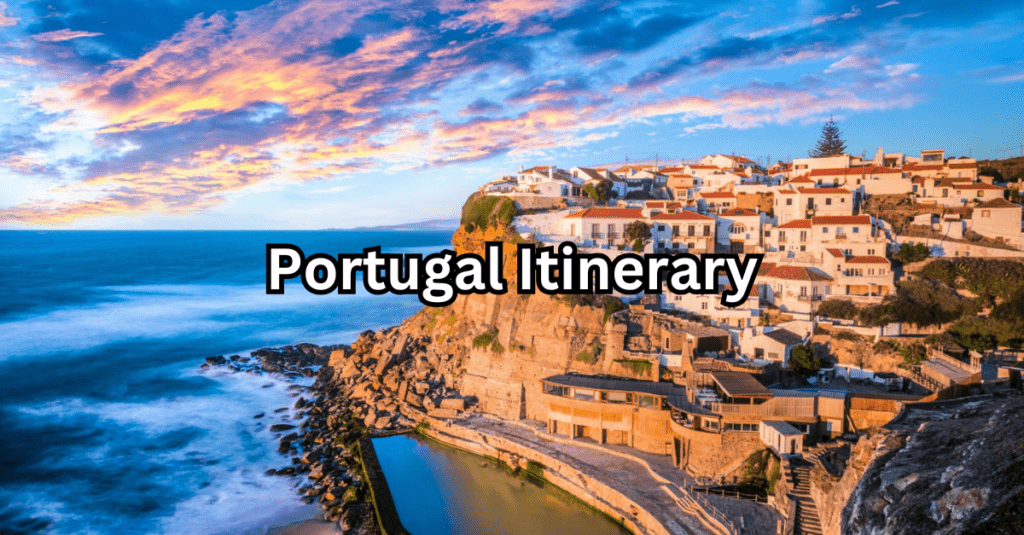Portugal is a captivating European destination that draws millions of visitors every year. In 2024, ...
Travel Guides
Ready to explore Portugal’s golden beaches, historic cities, and scenic wine country but unsure how to fit it all in? This ultimate Portugal itinerary reveals exactly what to see, eat, and do, whether you’ve got one week or more.


Portugal, with its sun-drenched coast, medieval towns, and soulful fado music, is a dream destination. From the azulejo-covered streets of Lisbon to the vineyard terraces of the Douro Valley and the clifftop beaches of the Algarve, the country offers a blend of history, culture, and world-class cuisine.
Whether you’re here for a quick city break or a deep dive into Portugal’s diverse landscapes, this guide will help you plan the perfect trip, ensuring you experience the country’s highlights without feeling rushed.
Start your morning in Alfama, Lisbon’s oldest district, where labyrinthine alleyways lead to breathtaking viewpoints. Climb to Miradouro de Santa Luzia, a romantic terrace overlooking the city’s red rooftops and the Tagus River. Wander uphill to Castelo de São Jorge (€15), a medieval fortress offering sweeping views of Lisbon.
Next, hop on the historic Tram 28 (€3), which winds through Lisbon’s most charming neighborhoods, including Graça and Baixa. Stop at Praça do Comércio, Lisbon’s grand riverside square, then take the Elevador de Santa Justa (€5.30) for another panoramic view.
Whether you're looking for luxury stays with rooftop views or affordable boutique hotels in the heart of the city, Lisbon offers a variety of accommodations for every traveler. Check out our full guide to find the best hotels in Lisbon.
Take a 40-minute train from Lisbon to Sintra, a fairytale town nestled in the hills. Your first stop is Palácio da Pena (€20), a 19th-century palace with colorful turrets and Moorish influences. Next, explore the gardens and underground tunnels of Quinta da Regaleira (€15), known for its Initiation Well, a spiral staircase leading into the earth.
After lunch at Tascantiga, a cozy eatery serving petiscos (Portuguese tapas), head to the Cabo da Roca, the westernmost point of mainland Europe, where dramatic cliffs meet the Atlantic Ocean.
On your way back to Lisbon, stop in Cascais, a charming coastal town. Stroll along the waterfront promenade or relax at Praia da Rainha, a small but scenic beach. Grab a pastel de nata at Santini, known for serving some of Portugal’s best gelato.
Take a high-speed train (2h 50m, from €25) to Porto, the second-largest city in Portugal. Start at Ribeira, the colorful, UNESCO-listed riverside district. Walk along the Dom Luís I Bridge, designed by a student of Gustave Eiffel, for a spectacular view over the Douro River. Explore the Livraria Lello (€8), a stunning bookstore that inspired J.K. Rowling’s vision of Hogwarts.
Then, take a traditional rabelo boat tour (€12.50 per person) along the Douro River, passing beneath Porto’s six bridges. In the evening, cross to Vila Nova de Gaia and visit a port wine cellar like Graham’s (€30 for a tour and tasting). For those staying overnight, the city offers a variety of options. Here’s a look at the best hotels in Porto.
Source: Porto Travel Guide
Wake up early for a day trip to Douro Valley, one of the world’s oldest wine regions. Start in Pinhão, a small village at the heart of the valley, where you can visit Quinta do Bomfim for a port wine tasting (€55–175).
Next, take a scenic river cruise along the Douro River, gliding past rolling vineyards and terraced hills. For lunch, dine at DOC, a Michelin-recommended restaurant offering regional dishes with stunning riverside views (around €40 per dish).
In the afternoon, visit another winery, such as Quinta da Pacheca, where you can tour the vineyards and even sleep in a wine barrel if you choose to stay overnight. Return to Porto for a relaxed evening, perhaps stopping for a sunset drink at Miradouro da Vitória.
Travel 1.5 hours by train from Porto to Coimbra, Portugal’s medieval university town. Visit Coimbra University (€13.50), one of Europe’s oldest, and explore the Baroque-style Joanina Library.
After lunch at Solar do Bacalhau, a renowned seafood spot, continue to Aveiro, known as the “Venice of Portugal.” Take a moliceiro boat ride (€10 for 45 minutes) through the town’s canals, then visit the Costa Nova beach, famous for its candy-striped houses. Return to Porto in the evening.
Fly 1 hour from Porto to Faro, then take a train or rental car to Lagos, one of the Algarve’s most beautiful coastal towns. Spend your morning at Ponta da Piedade, a dramatic limestone cliff formation with sea caves and golden arches. Kayak tours (from €30) offer an up-close view of the grottoes.
Relax at Praia do Camilo, a small beach with turquoise waters, before heading to Praia da Marinha, often ranked among the most beautiful beaches in Europe. For dinner, try O Camilo, a seafood restaurant with breathtaking ocean views.
Wake up early for a boat tour (from €30) to Benagil Cave, a stunning sea cavern with a natural skylight. If you’re up for an adventure, rent a stand-up paddleboard (€21 per person) to paddle inside the cave yourself.
Afterward, explore Faro, the Algarve’s capital. Wander the Old Town, visit the eerie Chapel of Bones (€2), then enjoy a relaxed lunch at Vila Adentro, a hidden gem serving traditional Algarvian cuisine. Catch a flight or train back to Lisbon for your final night.
For travelers looking to dive deeper into Portugal’s rich history, wine regions, and island escapes, extending your trip beyond a week offers even more unforgettable experiences.
A 1.5-hour train or drive from Lisbon brings you to Évora, a UNESCO-listed city and the heart of Portugal’s Alentejo region. Known for its well-preserved medieval streets, ancient Roman ruins, and rolling vineyards, Évora is a perfect blend of history and gastronomy.
Start your day at the Templo Romano de Évora, a striking Roman temple dating back to the 1st century AD. Just a short walk away, step inside the Capela dos Ossos (€6), a haunting yet fascinating chapel adorned with thousands of human bones and skulls, built by 16th-century monks as a memento mori.
In the afternoon, explore Herdade do Esporão, one of Alentejo’s most famous wineries (tours from €15). For those staying overnight, Convento do Espinheiro offers a luxurious stay in a converted 15th-century monastery.
Fly 1.5 hours from Lisbon to Funchal, the vibrant capital of Madeira, Portugal’s Atlantic island paradise. Nicknamed the "Island of Eternal Spring," Madeira is famed for its lush green landscapes, dramatic cliffs, and world-renowned fortified wine.
Start your day with a scenic cable car ride (€18,90 for a round trip) up to Monte Palace Tropical Garden, a botanical oasis with exotic plants, koi-filled ponds, and traditional azulejos.
In the afternoon, go on the Pico do Arieiro hike, one of the most scenic trails in Madeira with jaw-dropping views above the clouds. Alternatively, take a boat trip (from €30) to spot marine wildlife.
Day 10: Azores
A 2.5-hour flight from Lisbon lands you in the Azores, an archipelago of volcanic islands in the middle of the Atlantic. Known for crater lakes, geothermal springs, and untouched landscapes, São Miguel, the largest island, is the ideal starting point.
Begin your adventure at Sete Cidades, a twin-lake wonder formed inside a volcanic crater. The Miradouro da Boca do Inferno viewpoint offers a postcard-perfect panorama of the emerald and sapphire lakes below.
Next, unwind in the Terra Nostra hot springs (€16) in Furnas, a steamy, mineral-rich thermal pool surrounded by botanical gardens. In the afternoon, visit Lagoa do Fogo, a pristine crater lake surrounded by lush forests, or take a whale-watching tour to spot whales and dolphins in their natural habitat.
For those with two weeks in Portugal, this itinerary allows for a deeper exploration of the country’s diverse landscapes, from medieval villages to Atlantic islands, while giving time to enjoy Portugal’s renowned food and wine.
Take a one-hour train from Porto to Guimarães, known as the "birthplace of Portugal." Stroll through its medieval Old Town and visit the Guimarães Castle (€2), a 10th-century fortress where Portugal’s first king was born.
In the afternoon, travel to Braga, one of Portugal’s oldest cities. Visit Bom Jesus do Monte (€3 round trip by funicular), a stunning baroque sanctuary with an iconic zigzagging staircase leading up to panoramic views. Return to Porto in the evening.
Source: Deltatur
Rent a car for a scenic drive into the Serra da Estrela mountains, home to Portugal’s highest peaks. Hike through glacial valleys, visit Torre, the country’s highest point, and sample Queijo da Serra, a creamy sheep’s cheese unique to the region.
Stay overnight in Casa das Penhas Douradas, a boutique mountain lodge with breathtaking views.
Source: Peniche by Benoit Properties
Head to the surf town of Peniche, famous for its powerful Atlantic waves. Take a boat tour to the Berlengas Islands, a nature reserve with crystal-clear waters perfect for snorkeling.
Next, drive to Óbidos, a picture-perfect medieval village enclosed by 14th-century walls. Stroll through Rua Direita, lined with whitewashed houses and flower-filled balconies. End the day with a glass of ginjinha, a cherry liqueur served in a chocolate cup, at a local tavern.
Source: Vitor Estrelinha for London Surf Film Festival
Spend your last day in Nazaré, Portugal’s legendary surf town, where the biggest waves in the world crash against the cliffs. Visit the Fort of São Miguel Arcanjo, where surfers launch themselves into 100-foot waves.
After lunch at A Celeste, famous for grilled fresh fish, return to Lisbon for your final evening. Enjoy a farewell dinner at Belcanto, a two-Michelin-starred restaurant, before heading home. Currently ranked #31 on "The World's 50 Best Restaurants" list, this dining spot is renowned for its exceptional cuisine.
Staying connected in Portugal is easy, with reliable WiFi in hotels, cafes, and public areas, though speeds vary in rural regions. For uninterrupted access, a traditional SIM card or eSIM helps avoid roaming fees. eSIMs offer seamless connectivity without swapping cards.
Here’s a comparison of the best eSIM providers for Portugal, including prices and key features:
| Provider | Pros | Cons | Price | |
| Holafly | Unlimited data, 24/7 customer support | Data sharing unavailable | From $6.90 | |
| GigSky | Easy online purchase, flexible short-term plans | Higher prices for larger data plans | From $8.99 | |
| WifiMap | Budget-friendly, small data plans available | Limited coverage compared to other providers | From $4.72 | |
Lastly, Portugal plug types include Type C and Type F with a 230V supply, meaning travelers from the UK, US, and other regions may need an adapter. Most modern electronics like smartphones and laptops support 100V-240V, so a plug adapter is usually sufficient, without the need for a voltage converter.
10 days is ideal to see Lisbon, Porto, the Algarve, and some hidden gems. A week covers the highlights.
With nearly 600 miles of Atlantic coastline, Portugal offers some of Europe's best beaches.
Most popular dishes include Bacalhau (salted cod), Pastéis de Nata (custard tarts), and Caldo Verde (green soup).

